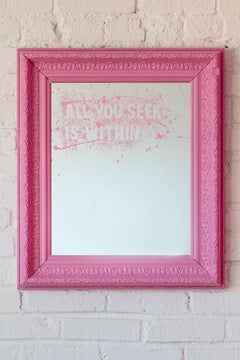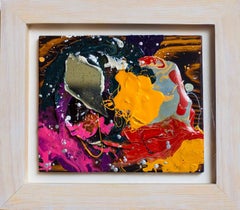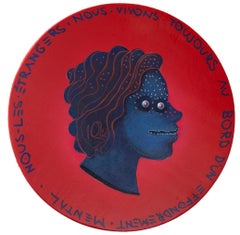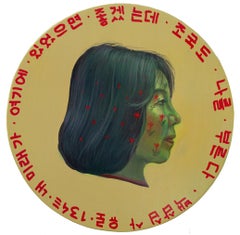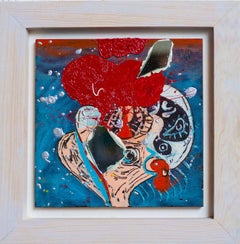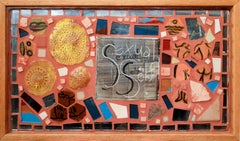Mirror More Art
to
2
1
1
Overall Width
to
Overall Height
to
4
14
6
4
4
3
1
20,214
1,204
987
745
712
2
2
Style: Contemporary
Medium: Mirror
"Coalescence #2" 21" x 16" inch by Oleg Char
Located in Culver City, CA
"Coalescence #2" 21" x 16" inch by Oleg Char
Medium: Spray paint, Acrylic on restored Antique Mirror, Wood frame
THE ARTIST:
Unearth the essence of contemporary art with Oleg Char ...
Category
21st Century and Contemporary Contemporary Mirror More Art
Materials
Mirror, Wood, Spray Paint, Acrylic
"Coalescence #1" 25" x 21.5" inch by Oleg Char
Located in Culver City, CA
"Coalescence #1" 25" x 21.5" inch by Oleg Char
Medium: Spray paint, Acrylic on restored Antique Mirror, Wood frame
THE ARTIST:
Unearth the ...
Category
21st Century and Contemporary Contemporary Mirror More Art
Materials
Mirror, Wood, Spray Paint, Acrylic
Serie: Abstractos con espejo 8
By Ray Smith
Located in Cuernavaca, Morelos
Mixed technique
Category
2010s Contemporary Mirror More Art
Materials
Mirror, Wood, Paint
Serie: Mujeres con espejo 5
By Ray Smith
Located in Cuernavaca, Morelos
Mixed technique
Category
2010s Contemporary Mirror More Art
Materials
Mirror, Wood, Paint
Related Items
"Currency #201" Blue Portrait Artwork with French Text on Red Background
Located in FISTERRA, ES
“Currency #201” is a circular mixed media portrait on wood featuring a surreal blue figure against a vibrant red background. Around the head, the French inscription reads: “Nous, les...
Category
2010s Pop Art Mirror More Art
Materials
Wood, Spray Paint, Acrylic
$184 Sale Price
20% Off
H 0.99 in Dm 10.24 in
Green and Yellow Circular Portrait Painting on Wood With Korean Inscription
Located in FISTERRA, ES
Circular acrylic portrait on wood exploring migration, longing, and imagined belonging through the interplay of language, color, and symbolic form.
Currency #257 by Natasha Lelenco ...
Category
2010s Contemporary Mirror More Art
Materials
Wood, Spray Paint, Acrylic
$210 Sale Price
20% Off
H 0.99 in Dm 10.24 in
French Contemporary Art by Paul Gallaud - Acrylic Osmose Bande 02
By Paul Gallaud
Located in Paris, IDF
Dibond mirror
Paul Gallaud is a French visual artist born in 1984 who lives and works in Croix, near Lille, France. After graduating with a BAC STI Applied Arts at the Institut Sain...
Category
2010s Contemporary Mirror More Art
Materials
Mirror
$237
H 3.94 in W 3.94 in D 0.79 in
Portrait of a Gentleman, David Erskine, 13th Laird of Dun, Wearing Armour c.1700
Located in London, GB
The gentleman in this exquisite oil on canvas portrait, presented by Titan Fine Art, is shown with the grandiloquence characteristic of the English School of painting. He is portray...
Category
17th Century Old Masters Mirror More Art
Materials
Oil, Canvas
$7,968
H 35.44 in W 30.71 in D 2.37 in
Portrait of Lady, Barbara Herbert, Countess of Pembroke c.1708, Large Painting
Located in London, GB
Portrait of Barbara Herbert, Countess of Pembroke c.1708
Charles d’Agar (1669-1723)
This magnificent large-scale portrait, presented by Titan Fine Art, depicts the British court of...
Category
17th Century Old Masters Mirror More Art
Materials
Cotton Canvas, Oil
$17,209
H 49.61 in W 46.86 in D 2.76 in
"Sweet Struggle" (2025) Original Abstract Figurative Oil Painting on Board
Located in Denver, CO
Michelle Jader's "Sweet Struggle" is a beautiful, original oil painting on board. This piece is framed at 12.50 x 9.50 inches, and is ready to hang.
Change comes to all of us. Wheth...
Category
2010s Contemporary Mirror More Art
Materials
Mirror, Oil, Panel
Portrait of a Lady, Mrs Wray in a Silk Dress & Pink Wrap c.1698, Oil on canvas
By Michael Dahl
Located in London, GB
Portrait of a Lady, Mrs Wray in a Silk Dress & Pink Wrap c.1698
Circle of Michael Dahl (1659-1743)
This delightful work, presented by Titan Fine Art, is a fine example of British po...
Category
17th Century Old Masters Mirror More Art
Materials
Cotton Canvas, Oil
$14,033
H 34.65 in W 29.93 in D 2.37 in
Portrait of a Gentleman, Doublet & White Ruff, Gloves Inscribed 1624, on panel
By Frans Pourbus the Younger
Located in London, GB
Titan Fine Art presents this exquisite oil on panel portrait depicting a handsome young gentleman in an exuberant black damask doublet. The pose, with one hand holding gloves and the other akimbo, was one that was well-established for gentleman of the upper echelons of society by the time this work was painted. The principle governing portraits at this time was the recording and defining in visual terms of the position of a sitter in society. In addition to brilliant and complex symbols of luxury, they often contained many symbolic elements too; the inclusion of gloves was often used in portraits that celebrated a betrothal as in ancient times gloves were used to seal a marriage contract.
The extraordinary costume of a black shimmering doublet, the brilliant white reticella ruff, and the cuffs edged with lace were immensely costly… this attire proclaims to every onlooker that this is a superior being. The rendering of the reticella lace ruff is exquisite and the artist has recorded the design that runs through the black damask fabric with meticulous attention to detail. The preservation of this black pigment is remarkable considering the age of the work. Black pigments are especially vulnerable to fade and wear over time partly due to environmental condition but also from unprofessional cleaning. This work is an exquisite example from the period.
According to the inscription in the upper right, the gentleman was in his 22nd year of age in 1624. The coat of arms, which is displayed without a crest, may be ‘blazoned’ in the language of heraldry, as: Sable on a Chevron between in chief two Roundels and in base a Billet [or possibly Square] Or three Martlets Sable. In plainer English this means a black (Sable) background, spanned by a gold (Or) chevron, above which are two golden solid circles (Roundels), and below which is a gold rectangle (Billet); on the chevron are three small black birds (Martlets). Martlets are a stylised form of heraldic bird, believed to be based on the swift, which are conventionally drawn with small tufts instead of feet. In Continental Europe it is also conventional for them to be drawn without beaks, as appears to be the case here. The birds in this instance also have a vaguely duck-like appearance.
Five families have been identified with very close armorial bearings to the one in our portrait. They are the (van) Houthem’s (of Brabant), the Prévinaire’s (of Flanders and Holland), and the Proveneer’s (of Liège) and it must be noted that the locations of these families also fit with the painting’s Flemish origins. However the French Grenières’s (of Île-de-France) and the Jallot’s (of Normandy) are the next closest matches and plausible matches, as Frans Pourbus had settled in Paris just a few years before our portrait was painted.
This painting has been assessed by a professional conservator prior to going on sale, and as thus, it can be hung and enjoyed immediately.
Frans Pourbus the Younger...
Category
17th Century Old Masters Mirror More Art
Materials
Oil, Wood Panel
$17,879
H 42.13 in W 31.11 in D 3.94 in
Portrait of Gentleman, Sir Henry Hobart, Blue Cloak & cravat, Wissing oil canvas
By Willem Wissing
Located in London, GB
Portrait of a Gentleman, Sir Henry Hobart Blue Cloak and cravat c.1683-1684
Attributed to Willem Wissing (1656-1687)
This impressive portrait, presented by Titan Fine Art, depicts t...
Category
17th Century Old Masters Mirror More Art
Materials
Cotton Canvas, Oil
$12,388
H 37.01 in W 31.5 in D 3.94 in
Portrait of Gentleman Blue & Cloak, Portrait of Lady, Fine Carved Gilded frames
Located in London, GB
Portrait of a Gentleman with Blue Cloak and Portrait of a Lady in Russet Dress c.1697
Thomas Murray (1663-1735)
These fascinating portraits are exquisite examples of portraiture in ...
Category
17th Century Old Masters Mirror More Art
Materials
Oil, Canvas
$27,120
H 37.8 in W 33.47 in D 2.76 in
Portrait Gentleman Armour, Blue Cloak, Diamond Brooch c.1700 French Carved Frame
Located in London, GB
Portrait of a Gentleman in Armour and Azure Cloak with Diamond Brooch c.1700
Attributed to Joseph Vivienne (1657-1735)
The sitter in this superb portrait, offered by Titan Fine Art...
Category
17th Century Old Masters Mirror More Art
Materials
Oil, Cotton Canvas
$18,013
H 35.83 in W 29.93 in D 3.15 in
Dutch Old Master Portrait of Maurits, Prince of Orange-Nassau, Oil on Panel
Located in London, GB
In 1607, the Delft city council decided to commission a portrait of Stadholder Maurits of Nassau for the town hall, with Michiel van Mierevelt as the chosen artist due to the passing...
Category
17th Century Old Masters Mirror More Art
Materials
Oil, Wood Panel
$11,584
H 37.8 in W 33.47 in D 2.37 in
Previously Available Items
Serie: Abstractos con espejo 2
By Ray Smith
Located in Cuernavaca, Morelos
Mixed technique
Category
2010s Contemporary Mirror More Art
Materials
Mirror, Wood, Paint
"Sexual Self" Woodcut Relief, Mirror and Glass Mosaic
By Isaiah Zagar
Located in Philadelphia, PA
"Sexual Self" is an original mosaic by Isaiah Zagar measuring 17in x 29in. This piece ships in the pictured wooden frame.
Isaiah Zagar is an award-winning mosaic mural artist who...
Category
21st Century and Contemporary Contemporary Mirror More Art
Materials
Clay, Mirror, Mixed Media, Mosaic, Woodcut
Mirror more art for sale on 1stDibs.
Find a wide variety of authentic Mirror more art available on 1stDibs. While artists have worked in this medium across a range of time periods, art made with this material during the 21st Century is especially popular. If you’re looking to add more art created with this material to introduce a provocative pop of color and texture to an otherwise neutral space in your home, the works available on 1stDibs include elements of orange and other colors. There are many well-known artists whose body of work includes ceramic sculptures. Popular artists on 1stDibs associated with pieces like this include and Isaiah Zagar. Frequently made by artists working in the Contemporary, all of these pieces for sale are unique and many will draw the attention of guests in your home. Not every interior allows for large Mirror more art, so small editions measuring 0.1 inches across are also available Prices for more art made by famous or emerging artists can differ depending on medium, time period and other attributes. On 1stDibs, the price for these items starts at $120 and tops out at $167,108, while the average work can sell for $1,403.
Recently Viewed
View AllMore Ways To Browse
Gilbert Magu Lujan
Glacier National Park Paintings
Gone Fishing Vintage
Gordon Setter
Graham Boyd
Grapevine Oil Painting
Great Dane Painting
Greek Artists Painting
Grouse Shooting
Harry Adams
Harry Day Paintings
Harvey Parks
Hedge House
Henry Collins
Hermes Birkin Bag 15
Highland Cow Painting
Hippo Painting
Hoppe Oil

